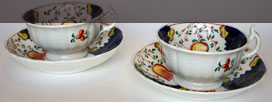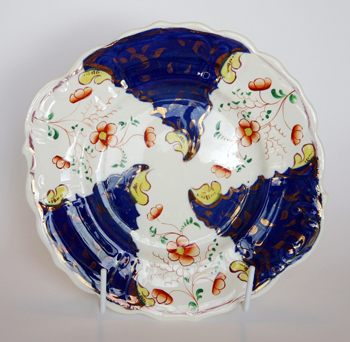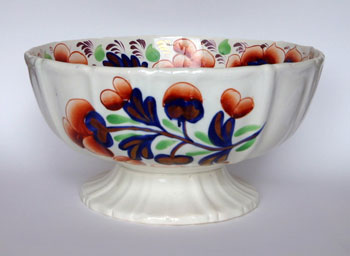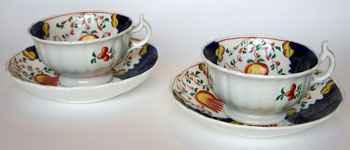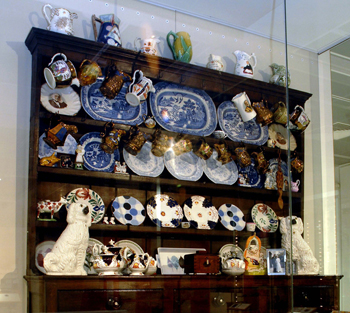Interpreting Ceramics | issue 13 | 2011 Articles & Reviews |
|
|||||||
Gaudy Welsh China:History, Technology, Design and Decoration
Jennifer Lewis |
|
|||||||
|
Abstract Key words: Gaudy Welsh, domestic ware, history, technology, social settings, hand-painted Introduction My involvement with Gaudy Welsh china began as a child in the 1950s in Mountain Ash, a mining town in the South Wales valleys. In this place coal mining is now an historical feature, but in those days it was a large part of peoples' everyday lives. A Gaudy Welsh tea service was displayed in the front room of our family home. Made in about 1860, it had been given to my great grandmother as a wedding present. She handed it down to her son's first wife, and it later passed to his second wife (my grandmother), and then to my mother. My mother called the tea service 'Swansea Cottage' not 'Gaudy Welsh' and said it was 'worth something'. In saying this she did not mean that it had great monetary value, but that it was distinctive and remarkable in its own way. The service is a very cheerful thing, made up of cups, saucers, small plates, serving plates, a teapot, sugar bowl, slop bowl and jug. It is in the 'Tulip' pattern, hand painted in brilliant colours of cobalt blue, copper lustre, yellow, burnt orange and green. I admired it as a child because of these colours, bright and joyful. One day, it was said, the tea service would come to me. While unpacking the tea service in my Australian home in 2007, I thought about its I found that the tea service I had admired in our small domestic space is part of the huge output of British ceramics in the nineteenth century. Gaudy Welsh, in effect, marks the transition between hand-crafted and mass produced china. It emerged that the service is more than an aspect of Welsh identity and visual tradition. It has international connections. Its pattern and design reflect a Japanese influence and its significance links to its popularity in North America. Gaudy Welsh started off as 'cheap and cheerful' and remains so. Pieces that sold for pennies at fairs and market stalls in the 1860s may still be bought for a relatively modest price on eBay. One of the most interesting aspects of Gaudy Welsh is the place it has occupied in the lives of ordinary people. The women in my family recognised its intrinsic value and assigned meaning to individual pieces. It seems likely that this viewpoint was common, as well as the practice of identifying a young girl in the family to be the next custodian. This article contributes to the story of Gaudy Welsh china. It comprises four sections:
Section One: Annotated bibliography This section presents detail of major categories of information relating to Gaudy Welsh Little has been written on the topic of Gaudy Welsh china. As a comparatively cheap, unmarked household ware, it sits outside the points of reference of fine quality porcelain. Scholarly publications seldom mention everyday china. They are, however, relevant to a study of Gaudy Welsh because they describe the larger context of ceramic manufacture and technology. Important contributions to understanding Gaudy Welsh have been made by Howard Williams (1978), Monica South (1997 and 2002), Sam Laidacker (1954) and John Shuman (1991).1 Additionally, there is a range of more popular writing that has been important in maintaining focus within the collecting community. The visual impact of Gaudy Welsh china and its important cultural and social roles are discussed in later sections of this article. This first section refers to museum collections as well as some alternative critical frameworks for discussing everyday domestic objects. Major reference books Howard Williams' Gaudy Welsh China, published in 1978, is the nearest we have to a definitive text on Gaudy Welsh. This reference book, based on extensive research and access to major collections in Wales, is an important contribution to the literature. Gaudy Welsh China is a scholarly approach to the topic, based on original research by an American academic of Welsh descent.2 Williams explains his methodology and his writing is measured and substantiated with footnotes and bibliography. Williams' perspective on Gaudy Welsh is straightforward. He describes himself as an enthusiast and collector and claims that china is most interesting when approached in terms of its fabricators, consumers and their environment.3 His book is an historical narrative around these themes. In contrast, the strength of Monica South's Gaudy Welsh Visual Reference Books, two volumes published in 1997 and 2002, lies in the extensive illustrative evidence presented. Her books are almost totally comprised of colour plates of Gaudy Welsh pieces. Over 200 patterns are illustrated in Volume One, and 160 in Volume Two. South's emphasis on visual references relates to her lifetime's work as an antique dealer and collector.4 The collecting community is interested in identifying and labelling; in patterns with their associated names and numbers. She is, above all, a great enthusiast and promoter of Gaudy Welsh, writing that the vast array of patterns and shapes never fail to excite the imagination.5 The reference books by Williams and South draw on co-operation from museum curators, mentors and other enthusiasts. Many of the items illustrated in the books are from major museums and private collections.
Scholarly publications A network of international ceramic circles and ceramic societies are responsible for a range of authoritative publications that contribute to an understanding of ceramic production.6 Of these, the English Ceramic Circle (ECC) has been at the forefront in documenting the work of British potteries, production methods, craftsmen and artists, beautiful and unusual items. In addition to publishing scholarly publications, the ECC also sponsor seminars and publish the resultant proceedings. A fine example of this contribution is Welsh Ceramics in Context edited by Jonathan Gray and published in two volumes in 2003 and 2005.7 Welsh Ceramics in Context includes Robert Copeland's paper Pottery manufacturing processes of the eighteenth and nineteenth century.8 This paper is based on early accounts of visits to Welsh potteries and is of value in understanding where Gaudy Welsh sits on a technological/production timeline in comparison with other china. A further type of scholarly publication focuses on the accomplishments of individual Welsh factories.9 Some of these studies are outstanding publications. A case in point is the most famous study of Welsh ceramics, Edward Morton Nance's definitive work, The Pottery and Porcelain of Swansea and Nantgarw, published in 1942.10 This work was the result of a lifetime of collecting and extensive research on the history and the production methods of the Welsh factories. Some of the more serious publications give historical overviews or general summaries of a range of factories.11 Robert Pugh in his 1995 publication Welsh Pottery is one of few writers to mention Gaudy Welsh, and this is in order to clarify confusion surrounding the name, its early manufacture and great popularity in Wales.12 There is a strong connection between a scholarly approach and museum/gallery collections.13 A growing number of on-line publications contain selected highlights of ceramic collections with images of items, descriptions and interpretation. From a Gaudy Welsh perspective the most useful ones are Gathering the Jewels, Swansea Heritage Netand Exploring the Potteries.14 American contribution One of the interesting aspects of Gaudy Welsh is that it is better known in North America, where much of it was exported and sold, than in Britain, its country of manufacture. The name 'Gaudy Welsh' was introduced by Americans and American dealers, traders and collectors have been influential in popularising the ware. The earliest efforts to categorise and establish the origins of Gaudy Welsh started with Sam Laidacker and his pioneering Anglo-American China series published from 1938 – 1954.15 His books were aimed at a growing number of china collectors for which identifying and observing different characteristics were important considerations in buying and trading items. Another author who has contributed to the growth of interest in Gaudy Welsh is John Shuman. Shuman takes up the identification debate in his Collector's Encyclopedia of Gaudy Dutch and Welsh published in 1991.16 This work is about recognising the similarities and differences between the two wares and includes a study of the shapes, patterns and colours of Gaudy Welsh. Shuman's textual descriptions of various patterns are particularly useful for identification. Popular writing Laidacker founded the 'American Antiques Collector' in 1939 and published twenty-nine issues of this journal in the period 1939–1956.17 The journal contains information on hand decorated wares including Gaudy Welsh. Schuman contributed over a thousand articles to other antique journals including pieces on the 'two Gaudies'.18 Gaudy Welsh continues to be a regular topic of interest for an extensive range of journals and trade guides.19 The antiques and collectables industry includes fairs, show circuits, collectors clubs, television programmes and expos. EBay has opened the door to online purchasing. Information on Gaudy Welsh china is available through an array of web based tools.20 Never before in the history of ceramics collecting has it been possible to connect so effectively with a chosen pastime. The more popular writing on Gaudy Welsh is not necessarily based on independent study. Descriptions rely heavily on the work of Laidacker, Williams and Shuman. However, in describing the attractiveness and intrinsic appeal of Gaudy ware, these publications are critical to keeping interest and trading alive.
Textual and visual sources Some of the words that have been used to describe Gaudy Welsh pieces are 'colourful', 'cheerful', 'gorgeous', 'rustic', 'exuberant' and 'blaze of colour'. These words provide good clues to the richness of the design and decoration of the pieces. Textual descriptions of the actual patterns may be used as a means of identification and association. Shuman's description of the 'Tulip' pattern, for example reads,
Moving beyond textual descriptions, photographs and sketches provided in the literature, particularly in South's Visual Reference Books, give a good 'feeling' for the shapes, designs and intensity of colours.22 The experience of looking at actual pieces is more immediate. In South Wales, important Gaudy Welsh collections may be found in the National Museum of Wales Cardiff; St Fagans National History Museum; the Swansea Museum; the Glynn Vivian Art Gallery Swansea; and Cyfarthfa Castle Museum and Art Gallery Merthyr Tydfil. In the world of museums, the meaning and significance of objects may be determined by the context of displays. There are two key ways that exhibitions and displays contribute to an understanding of Gaudy Welsh. Glass cabinet exhibitions such as those in the National Museum of Wales, the Glynn Vivian Art Gallery and the Swansea Museum display early Gaudy Welsh pieces made in Wales, thus documenting their essential ‘Welshness’. These pieces are marked 'Dillwyn, Swansea', a mark used by the Cambrian factory in the period 1831- 1850.23 At St Fagans, the Swansea Museum and Cyfarthfa Castle, a number of Gaudy Welsh pieces are exhibited as part of period recreations of typical Welsh homes. They are arranged on mantelpieces, Welsh dressers and corner cupboards, along with dinner services and souvenir china. This interpretative device acknowledges the special place Gaudy Welsh china occupies within Welsh visual culture.
New ways of interpreting With the changes that have occurred in institutions and the practice of art and cultural history over the last years, new ways of looking at objects have developed. These new ways of interpreting include feminist and structuralist approaches.24 The work of Moira Vincentelli (1992, 1993, 1994 and 2000)25 has opened up the study of ceramics to include questions about gender relations, meaning and identity. Her publications, as well as those of Jo Dahn (2000)26 and Penelope Collet (2008),27 offer fresh insights into the collection and arrangement of popular ceramics and women's creative expression. Popular ceramics displayed in a domestic setting convey a blending of layers of association and meaning. The pieces may be aesthetically and functionally pleasing, but it is also likely that they carry personal associations, memories or symbolic meaning. In summary, Gaudy Welsh is a topic for which there is little contemporary information. The focus of traditional scholarship has been in the field of prestigious ceramics not the cheaper everyday ware. Important contributions to understanding Gaudy Welsh have been made by Laidacker (pioneering), Williams (textual), South (visual), and Shuman (identification). The strong efforts of international enthusiasts and the community of collectors have been essential in keeping interest alive. Website information provides new opportunities for accessing images of museum collection. New ways of looking at objects in a domestic setting offer an approach that may contribute to a fuller appreciation of Gaudy Welsh. Section Two: Historical context Gaudy Welsh china is a cottage ware; a product that was made for sale in Britain (1820 -1860).28 It was produced across a broad geographical area during a period of great change and innovation within the pottery industry. Gaudy Welsh is of varied quality and workmanship, hand painted in floral and abstract designs with vibrant colours. The distinguishing features of manufacture, design and decoration are discussed in sections three and four of this article. Apart from these features what makes this ordinary household ware distinctive and remarkable? First, there are the distinct 'tangible' aspects of name, origins and enduring popularity in Wales and North America. Second, there are more 'intangible' aspects to Gaudy Welsh, related to its social and cultural context. Named by Americans The name 'Gaudy Welsh' is misleading in appearing to link the ware with the country in which it was made. In fact the name was introduced by Americans due to its popularity with Welsh people who migrated to North America as well as its bright decorative colours. As Moira Vincentelli points out, the word 'gaudy' as an adjective may be seen as having negative implications, suggesting something over bright, primitive or pleasing to popular taste.29 For many years this name was not familiar in Britain except amongst individuals It is closely related to Gaudy Dutch, and John Shuman's The Collector's Encyclopedia of Gaudy Dutch and Welsh is based on the two wares sharing a loosely knit connection. Shuman writes that both Gaudy wares were manufactured in Britain, exported to America for a poor class of people, use similar colours and in some cases exhibit many complementary motifs.30 Popularity According to Howard Williams, Gaudy Welsh was among the 'first people's pottery', colourful, free flowing and unpretentious.31 It was manufactured cheaply and sold to working class people, usually at fairs, markets and from door-to-door. From research undertaken by Williams, we know that two communities, the Welsh and the 'Welsh in exile', found Gaudy Welsh china very appealing. Thus the ware is linked to these people's ways of critical selection and how they viewed themselves.
Gaudy Welsh in Wales In the nineteenth century Wales was a mixture of small family farms and expanding industrial areas based on the export trades of coal, slate, iron and steel. It was predominantly a working class culture with little disposable income and with women working mostly in the home. Gaudy Welsh china was inexpensive and within the reach of ordinary people. As Vincentelli describes, the market for ceramics in Wales was complemented by a fine woodworking tradition and dressers and cupboards made by local carpenters were designed to be both useful and decorative.32 Right up to the present time, Gaudy Welsh jugs, plates and tea services have occupied pride of place on Welsh dressers. There is a particular association with tea services in the 'Tulip' pattern. The ware has retained its popularity in Wales and this continuing visibility provides its present Welsh connection. Gaudy Welsh in North America Gaudy Welsh is closely associated with Welsh people in North America. The States where it was initially popular are those of Pennsylvania, New York, Illinois and Ohio, where the majority of Welsh migrants (miners, steelworkers and farmers) settled. 'The real devotees of Gaudy Welsh are American', writes Williams adding that these tend to be people with common Welsh surnames such as Jones, Evans, Hughes, Roberts and Davis.33 Williams' explanation for this popularity is that the migrant Welsh were a 'visible people' who tended to establish their own communities and maintain their customs.34 It is likely that migrants carried the ware with them in their household effects and also bought exported pieces once they arrived in America. Sam Laidacker reported that British pottery and porcelain 'holds a charm for American collectors far greater than the ceramic work of any other country', adding that there was hardly a type that did not appeal to a number of collectors over a wide area.35 Large quantities of Gaudy Welsh were produced for the North American market. The most persuasive evidence of its enduring popularity is that the ware is now widely scattered throughout the United States. Social/cultural settings Returning briefly to my own connection with Gaudy Welsh, I remember the interior of my family home as being very dark, and the tea service on display as one of its few bright and lively aspects. The service was valued by the women in my family and this was manifested in a range of repetitive tasks such as dusting, washing and re-arranging pieces on shelves. These tasks had a distinctly meditative aspect and took place alongside rituals of spring cleaning and the changeover of winter and summer curtains. In my family, the tea service was traced back to four generations of women, their origins, the relationships between them, and their likes and dislikes. It was not like telling a family history; looking at the pieces facilitated spontaneous reflection on these women, reminiscing and story telling. The tea set uncovered their vitality, their daily lives and something of their individual identities. The work of Vincentelli has been influential in contributing to new ways of looking at objects in domestic settings. Her work on ceramics and gender reveals objects as a form of creative expression and bearers of meaning. It is not just that pride in the home may be expressed through the contents of the home. The collecting of china for display has become interwoven with a female identity and the place of display a signifier of both 'Welshness' and female domestic prowess.36 Vincentelli describes how objects, even those that are taken for granted, may become 'bearers of meaning'. With different uses and associations, meaning can also change over time and a ceramic object may become 'a rare messenger from a past age'.37 Other authors such as Jo Dahn and Penelope Collet deal with related aspects of emotional and sentimental attachment and women's creative expression. Dahn describes how everyday experiences may be interpreted through 'objectscapes'; the organisation of sets of domestic objects. The framework of an 'objectscape' may represent social contexts and signify family and social relationships.38 Collet makes a point, not often acknowledged when discussing feminine 'taste' and decorative ware. The 'bottom of the range' ceramic was all that ordinary working people could afford so it was an obvious choice in their efforts to create their own visual identity.39 These ways of interpreting the personal and family significance of ceramics in the domestic sphere resonate with my own involvement with Gaudy Welsh. If we accept that objects can be 'messengers from a past time' we may see something profound in a tea service first acquired in 1860, passed down through generations of women and the meaning it conveys in the present. It provides a connection to memories of the past and a link between past, present and future. Section Three: Technology The bulk of Gaudy Welsh china was manufactured 1820 - 1860, a period of economic expansion and increasing mechanisation in the pottery industry. The period was an exciting time with many new factories springing up as others closed down, with a corresponding mobility of owners, potters, technicians and designers. Much of the development within the British pottery industry has been attributed to business and technical innovations pioneered by Josiah Wedgwood in Staffordshire. This region became the centre for British potteries and a distinct Staffordshire style emerged. By the end of the Gaudy Welsh period the Staffordshire potteries workforce numbered close to 28,000.40 The making of Gaudy Welsh china sits along a production timeline that was moving from 'small family workshop' to 'factory production'. Change occurred at each stage of production and overall the result was cheaper manufacture, less individuality and economies of scale. In common with other household wares, Gaudy Welsh pieces gradually moved closer to mass production in terms of form, function, design and decoration. There are several aspects of Gaudy Welsh production about which we know very little. It is extremely difficult, for instance, to determine the date and attribution of individual pieces. Also little is known about the practice of assigning pattern names. It appears that they were not given at the time of production, but were developed later and over a considerable period of time.41 This section, while not providing new information on these questions, gives an updated summary of these aspects. Top of the page | Download Word document | Continued Notes To return to the article click the relevant note number 1 Howard Y. Williams, Gaudy Welsh China, Des Moines Iowa, Wallace Homestead Book Company, 1978; Monica A. South, Gaudy Welsh: a Visual Reference Book, Abergavenny, Monica South, 1997; Monica A. South, Gaudy Welsh, a Visual Reference Book, volume 2, Abergavenny, Monica South, 2002; Sam Laidacker, Anglo-American China Part 1, second edition, Bristol Pennsylvania, Sam Laidacker, 1954; John Shuman, III, The Collector’s Encyclopedia of Gaudy Dutch and Welsh, Paducah KY, Collector Books, 1991. 2 Williams spent a year in Wales researching and writing about Gaudy Welsh China. He is a descendent of Welsh emigrants to the United States in the late nineteenth century and has strong social ties to Wales. See Williams, Gaudy Welsh China. 3 Williams, Gaudy Welsh China, p.6. 4 Monica South lives in Wales; the foreword to her work is bilingual and she has well developed connections with American collectors and antique dealers. See South, Gaudy Welsh, a Visual Reference Book. 5 South, Gaudy Welsh, a Visual Reference Book, volume 2, p.13. 6 Some of these are English Ceramic Circle (founded in 1927, and the oldest of this group), the American Ceramic Circle, as well as various Ceramic Societies such as the Northern Ceramic Society. These Ceramic Circles and Societies are usually affiliated to major museums and galleries. Also worth noting are the publications of the Antique Collectors’ Club, which over a number of decades have produced a series of substantial volumes on many aspects of British ceramics, a number of which make reference to ‘Gaudy Welsh’ and other ‘Gaudy’ wares in the context of broader ceramic types eg Geoffrey A. Godden, Godden’s Guide to Ironstone, Stone and Granite Wares, Woodbridge, ACC, 1999. 7 Jonathan Gray (ed), Welsh Ceramics in Context, Part 1, Swansea, Royal Institution of South Wales, 2003; Jonathan Gray (ed), Welsh Ceramics in Context, Part 2, Swansea, Royal Institution of South Wales, 2005. This major publication examines and updates information on early Welsh ceramics and related English wares. 8 Robert Copeland, Pottery Manufacturing Processes of the Eighteenth and Nineteenth Century, in Jonathan Gray, (ed) Welsh ceramics in Context, Part 1, Swansea, Royal Institution of South Wales, 2003, pp. 39-52. 9 Several quality potteries were established in South Wales during the eighteenth and nineteenth centuries. The major ones were Nantgarw (1813-1823), Swansea (1814-1826) Cambrian (1764-1870), Glamorgan (1813-1839), South Wales Pottery, Llanelly (1839-1922) and Ynysmeudwy (1845-1875). 10 Ernest Morton Nance, The Pottery and Porcelain of Swansea and Nantgarw, London, Batsford, 1942. Nance collated his life's study into this publication, which is nearly 600 pages long and has at least 1,000 illustrations. (facsimile copy available). 11 See for example, Peter Hughes, Welsh China. An Illustrated Handbook, Cardiff, National Museum of Wales, 1972 and Robert Pugh, Welsh Pottery, Bath UK, Towy Publishing, 1995 12 See Robert Pugh, Welsh Pottery. 13 Nance, for example, bequeathed his collection of ceramics around which his work is based, to the National Museum Cardiff. See ‘The Morton Nance collection of Welsh pottery and porcelain’www.museumwales.ac.uk 14 ‘Gathering the Jewels’ www.gtj.org.uk, and ‘Swansea Heritage Net’ 15 Sam Laidacker is best known for his work compiling, classifying and cataloguing the many varieties of Staffordshire wares manufactured for the North American market. The first edition of Anglo-American China Part 1, was published in 1938 and the second edition in 1954. Anglo-American China Part II was published in1951. 16 See Shuman, The Collector’s Encyclopedia. The book is a two-part study that brings together ‘Gaudy Dutch’ and ‘Gaudy Welsh’ into a loosely knit kinship. Gaudy Dutch china was made in Britain from the late eighteenth century until the 1820s. It has sixteen patterns and while sharing many of the characteristics of Gaudy Welsh is of a higher quality. 17 David Arman, ‘Let Me Introduce You to Sam Laidacker’, China and Glass Quarterly’, Jan/Feb 1997, pp. 41-44. 18 ‘Meet the Authors’, John Shuman III www.collectorbooks.com (accessed 23 March 2010) 19 Articles include Gloria Dale, ‘Gaudy Welsh and Gaudy Dutch’, The Antique Collector, September 1984, pp. 89 – 91; Rosemary Sparks, ‘Gaudy Welsh’, Antiques and Collecting Magazine, February 1995, pp. 40-41 and 56-57. 20 See for example Glamorgan Antiques, ‘Introduction to Gaudy Welsh’ www.glamorganantiques.co.uk (accessed 5 November 2009) and Proudlove, Christopher. ‘Antique Welsh pottery, gorgeous Gaudy relics of a lost art’, www.writeantiques2.blogspot.com (accessed 5 November 2009). 21 Shuman, The Collector’s Encyclopedia, p. 137. 22 South, Gaudy Welsh, a Visual Reference Book; South, Gaudy Welsh, a Visual Reference Book, volume 2. 23 www.swanseaheritage.net/article/gat.asp?ARTICLE_ID-94 (accessed 23 March 2010). 24 For a general discussion of the development of a cultural/social approach see Jonathan Harris, The New Art History, a Critical Introduction, London, Routledge, 2001. 25 Moira Vincentelli, Talking Pots, Aberystwyth, University College of Wales, 1992; Moira Vincentelli, ‘Welsh Dressers and Ceramic Display’, Planet, the Welsh Internationalist: 100 August/Sept 1993, pp. 32–37; Moira Vincentelli, ‘Artefact and Identity: the Welsh Dresser as Domestic Display and Cultural Symbol’ in Our Sisters’ Land, edited by J. Aaron, S. Betts, T. Rees and M. Vincentelli, Cardiff, University of Wales Press, 1994, pp. 228-241; Moira Vincentelli, ‘The Welsh Dresser: a Case Study’, Interpreting Ceramics, Issue 1, 2000. (accessed 27 October 2009) . 26 Jo Dahn, ‘Mrs Delany and Ceramics in the ‘Objectscape’, Interpreting Ceramics, Issue 1, 2000. www.interpretingceramics.com/issue001/delany/delany.htm. (accessed 27 October 2009). 27 Penelope Collet, ‘A Commentary on Women Creating Spaces in Welsh Visual Culture’, Visual Culture & Gender, vol 3. 2008: 90-99. 28 Williams, Gaudy Welsh China. 29 See Vincentelli ‘Artefact and Identity’, p. 231. 30 Shuman, The Collector’s Encyclopedia, p. 97. 31 Williams, Gaudy Welsh China, p. 122. 32 Vincentelli, Talking Pots, p.19. 33 Williams, Gaudy Welsh China, p. 13. 34 Williams had personal knowledge of this through his own family tradition. Ieuan Williams writes that it was customary for ‘Yolen’ to be given as the middle name in the American branch of their family. ‘Llys Yolan’ was the name of the family’s farm in North Wales. See Ieuan Williams, ‘My Loose Connection with Gaudy Welsh’, 2/55 Gwynedd Roots, Autumn/Winter, 2008, p. 31. 35 Laidacker, Anglo-American China Part 1, Second edition, p. 67. 36 Vincentelli, ‘The Welsh Dresser: a Case Study’, p. 2. 37 Vincentelli, ‘The Welsh Dresser: a Case Study’, pp.2-3. 38 Dahn, ‘Mrs Delany and Ceramics’, p. 1. 39 Collet, ‘A Commentary on Women Creating Spaces’, p. 91. 40 Shuman, The Collector’s Encyclopedia, p. 143. 41 Pugh, Welsh Pottery, p. 57. |
||||||||
© The copyright of all the images in this article rests with the author unless otherwise stated |
||||||||
Gaudy Welsh China • Issue 13 |
